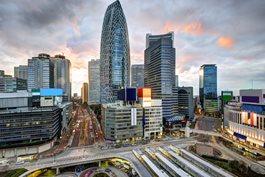
A landmark of Tokyo's eclectic architecture, the "Reversible Destiny Lofts" are enjoying a spike in popularity thanks to HBO's popular show GIRLS, which featured the iconic "death-defying" living units, as architects Shusaku Arakawa and Madeline Gins dubbed them, prominently in its latest season. The vibrantly colored units, which look more like a preschool playground than an upscale residence, plays home to Shoshanna, the somewhat shy NYU mathematics graduate who is living the ultimate twenties-something dream of working in an exciting and exotic foreign city and having life just "click."
Tokyo's unique architectural skyline is itself a coming-of-age story that dates back to the nineteenth-century when the growing imperial power sought to reinvent itself as a modern, Western nation with grandiose architecture to match its imperial ambitions. Rejecting the strict traditional aesthetic of the past, Japan's architects developed the International Style of modernism under heavy Western influence.
Like its Axis sister-city, Berlin, Tokyo suffered widespread fire bombing during World War II, and like Berlin, many of the city's iconic landmarks were destroyed. In rebuilding the capital, Japan's new post-war architects were first heavily influenced by Le Corbusier and Gropius's Bauhaus movement, but soon began to branch out on their own, creating structures and designs that defied categorization. The result is Tokyo's inimitable contemporary cityscape, which features some of the most innovative examples of modern and post modern architecture. These include the magnificent St. Mary's Cathedral, built in 1964 of glass and stainless steel, conceived by one of Tokyo's best-known architects, Kenzo Tange. The Mode Gokun Cocoon Tower, housing three Japanese institutes of higher learning, is a narrow skyscraper, conceived as a cocoon in which students can be inspired to grow, change, and transform. This building challenges the idea of a large traditional campus, covering acres of land. Instead, the semi-circular classrooms radiate at 120 degree angles from the central stalk, which contains high-speed elevators. Three-floor student centers are light and airy, offering an ease of movement and interaction between the inhabitants.
Japan's modern architects often incorporate aspects of the traditional in their designs, such as the Yoyogi National Gymnasium, built for the 1964 Olympic Games, where you can feel distinct echoes of Japan's traditional architecture in the pagoda-style roof. As Tokyo gears up to host the 2020 Summer Olympics, Japanese architects are already turning their attention to the need for more sports facilities and an increase in hotel room capacity. The latter has sparked heated debate over the controversial tearing down of one of Japan's best-loved post-war structures, the Hotel Okura. Built to accommodate guests for the 1964 Olympics, the unique character of the hotel's main building has prompted both Japanese and foreign architecture buffs to mount a fervent - but sadly unsuccessful - campaign to save this unique architectural monument. For the Japanese, it's all about moving on.
Join Alexander + Roberts on a unique journey of discovery of all that Japan's unique culture has to offer on carefully-developed itineraries such as
From Japan's Inland Sea to the Alps, always capped at 16 guests.